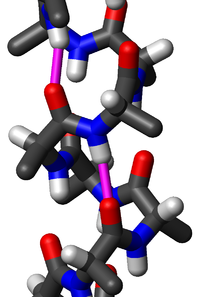Alpha helix
An alpha helix (α-helix) is a twisted part of a protein. It is one of the two most common parts of the secondary structure, or shape, of a protein. The other is the beta sheet. An alpha helix is created by alternating groups of atoms. There is a carbonyl group, created by a carbon atom double bonded to an oxygen atom, and an amine group, created by a nitrogen atom bonded to a hydrogen atom. Each section containing one of each of these groups is called a residue, a general term for a small part of a molecule. Each amine group forms a hydrogen bond with the carbonyl group four residues earlier. The alpha helix consists of 3.6 residues per turn. All hydrogen bonds face in the same direction. If two or more alpha helices come together, they become a tertiary structure. (Ex. Five alpha helices arranged into a barrel shape)

Alpha helices in disease change
A prion is a protein that causes disease by changing the shape of another protein. It does this by changing some of the alpha helices, which are more common in normal cells, to beta sheets, which are more common in prions.